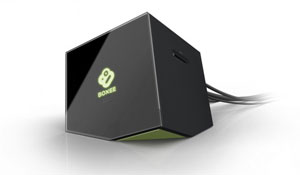
A box with Boxee is a box with Boxee, right? Not really. Despite the identical software running on D-Link’s Boxee Box and the brand new Iomega TV with Boxee, a handful of seemingly small but collectively significant features divide the two. We went hands on with the Iomega TV at CES 2011, and we’re convinced it’s the superior box. Here’s why.
 It’s not trying to be furniture.
It’s not trying to be furniture.
The Boxee Box whole chrome cube design with certainly caught eyes at CES last year, and earns some deserved points for originality, but it’s just not practical. Unless you live in a college dorm, it doesn’t fit in with any home decor, and when you go to stuff it in a AV cabinet, the awkward shape takes up way more room than it needs to. Iomega TV adopts a much lower key design that looks modest situation below a TV, or stuffs cleanly away in a shallow drawer – it’s even thin enough to put on top of other equipment, depending on your situation.
It comes with storage.
We’ve already established that buying an Iomega TV with built-in storage isn’t a particularly good deal on price-per-GB level, but at least Iomega gives you the option. We would rather string up a portable USB drive (which is still possible), but for someone who wants one tidy package, adding 1TB or 2TB or storage inside just makes sense.
Iomega is waiting out Boxee’s awkward adolescence.
D-Link delivered the Boxee Box later than expected and missing a critical feature – Netflix – then promised it by the end of the year and failed to deliver. Iomega TV will arrive in February when Netflix will already be available, giving consumers the experience they expect out of the box rather than putting them through upgrade after upgrade fix a half-baked product.
 It’s a versatile media server.
It’s a versatile media server.
Iomega TV ships with Iomega’s new Personal Cloud software, which basically means you can access it easily from anywhere. Shooting off an e-mail invite to family and friends gives them access to whatever you decide to share on the device, seamlessly. After they install a small client, it just appears as another drive letter. But forget about family and friends, we just want access to our treasure trove of movies from anywhere.
It has a trackpad.
Navigating the Web with D-Link’s Boxee Box is hell on earth thanks to the four directional keys, which make placing a cursor harder than snagging a teddy bear with a claw machine at the arcade. Iomega made the same directional keys double as a capacitive touchpad when the browser is open, for a much smoother, more natural mousing experience. The demo we tried lagged significantly, but Iomega claims it will improve by the time it ships, and even in its current state, it’s miles better than D-Link’s.
Editors' Recommendations
- I was wrong. Apple TV 4K is the best streamer you can buy
- Pray for Apple TV: Is this the end of the line for Apple’s streaming box?




